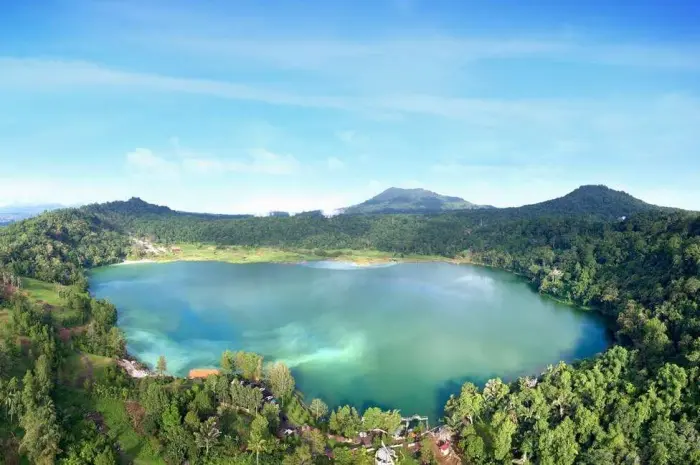Nestled amidst the lush landscapes and volcanic terrain of Tomohon, North Sulawesi, Indonesia, lies Lake Linow, a captivating natural wonder that beckons travelers with its enigmatic beauty and unique geological features.
Known for its ever-changing colors, geothermal activity, and serene ambiance, Lake Linow offers visitors a mesmerizing glimpse into the wonders of nature, making it a popular destination for tourists, nature enthusiasts, and photographers alike.
Join us on a journey of exploration as we uncover the secrets and allure of Lake Linow, inviting you to discover the hidden treasures of this picturesque volcanic crater lake.
1. Geological Marvel
Lake Linow is a volcanic crater lake formed within the caldera of Mount Lokon, an active volcano that dominates the landscape of Tomohon.
The lake’s unique geological features are attributed to its volcanic origins, with its crystal-clear waters, bubbling mud pools, and colorful mineral deposits creating a surreal and otherworldly landscape.
The lake’s changing colors, ranging from emerald green to turquoise blue and even shades of red and orange, are caused by the presence of sulfur and other minerals in the water, which react to sunlight and volcanic gases, resulting in a kaleidoscope of hues that mesmerize visitors.
2. Hydrothermal Activity
One of the most fascinating aspects of Lake Linow is its geothermal activity, which is evident in the form of hot springs, steam vents, and bubbling mud pools that dot the lake’s shoreline.
These hydrothermal features are a result of the underlying volcanic activity of Mount Lokon, which heats the groundwater and creates pockets of boiling water and steam that rise to the surface.
Visitors can witness the spectacle of steam rising from the lake’s surface, hear the gurgling sounds of bubbling mud pots, and even feel the warmth of the geothermal waters as they explore the lake’s surroundings, offering a unique and immersive experience of nature’s power and beauty.
3. Scenic Beauty
Surrounded by verdant hillsides, dense forests, and rugged volcanic landscapes, Lake Linow offers a scenic and tranquil setting that captivates the senses and soothes the soul.
The lake’s serene waters reflect the ever-changing colors of the sky, creating a picturesque tableau that is both captivating and serene.
Visitors can take leisurely walks along the lake’s perimeter, admiring the panoramic views of the surrounding countryside, or simply sit by the water’s edge and immerse themselves in the tranquility of nature, away from the hustle and bustle of city life.
4. Recreational Activities
Lake Linow offers a variety of recreational activities for visitors to enjoy, ranging from leisurely boat rides to exhilarating hikes and nature walks.
Adventurous souls can embark on guided treks to explore the rugged terrain surrounding the lake, with opportunities to discover hidden waterfalls, volcanic caves, and panoramic viewpoints along the way.
For those seeking a more relaxed experience, boat rides on the lake’s calm waters provide a tranquil way to soak in the scenic beauty and serenity of the surroundings, with knowledgeable guides providing insights into the lake’s geology, ecology, and cultural significance.
5. Ecological Diversity
Lake Linow is not only a geological marvel but also a haven for biodiversity, supporting a rich array of flora and fauna within its unique ecosystem.
The lake’s nutrient-rich waters sustain a variety of aquatic plants and algae, while its shores provide habitat for a diverse range of bird species, including kingfishers, herons, and egrets.
Surrounding forests are home to an abundance of wildlife, including macaque monkeys, tarsiers, and civet cats, adding to the ecological diversity and natural beauty of the area.
Visitors can observe wildlife in their natural habitat, with opportunities for birdwatching, nature photography, and eco-tourism activities that promote conservation and environmental awareness.
6. Cultural Significance
In addition to its natural beauty and ecological importance, Lake Linow holds cultural significance for the local community, serving as a sacred site and cultural landmark for the indigenous Minahasa people of North Sulawesi.
The lake is revered as a place of spiritual significance, with traditional rituals and ceremonies held by local communities to honor the spirits of the land and seek blessings for prosperity, health, and well-being.
Visitors can learn about the cultural heritage and traditions of the Minahasa people through guided tours, cultural performances, and visits to nearby villages, gaining insights into the rich tapestry of indigenous cultures that thrive in the region.
7. Sustainable Tourism Practices
As a popular tourist destination, Lake Linow is committed to promoting sustainable tourism practices that minimize environmental impact and preserve the natural beauty and ecological integrity of the area.
Local authorities and community groups work together to implement responsible tourism initiatives, including waste management programs, conservation efforts, and eco-friendly infrastructure developments that balance the needs of tourism with the protection of natural resources.
Visitors are encouraged to respect the environment, follow designated trails, and support local businesses and initiatives that contribute to the sustainable development of the area, ensuring that Lake Linow remains a pristine and cherished destination for generations to come.
Conclusion
Lake Linow stands as a testament to the power and beauty of nature, offering visitors a captivating blend of geological wonders, scenic beauty, and cultural heritage that captivates the imagination and inspires the soul.
Whether you’re drawn to its ever-changing colors, geothermal activity, scenic vistas, or cultural significance, Things to do in Tomohon invites you to embark on a journey of discovery and exploration, where every moment reveals a new facet of its enigmatic charm and timeless allure.
As you immerse yourself in the tranquility and serenity of this natural wonder, you’ll discover why Lake Linow is truly a must-visit destination in the heart of Tomohon, North Sulawesi.

